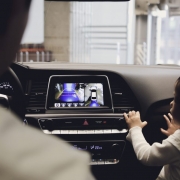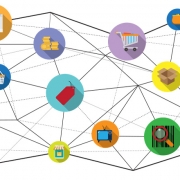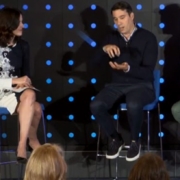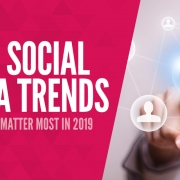Emerging Technologies That Will Transform Experiences
by Giselle Abramovich . . CMO.com
This article is part of CMO.com’s December series about 2018 trends, predictions, and new opportunities. Click here for more.
We’re all aware of the immense impact that technology has had on the ways in which consumers interact with brands.
Think about some early inventions—such as the telephone in 1876 and the television in 1926—which gave businesses an easy way to connect with consumers on a more intimate level, from the comfort of their homes. Fast-forward to the late 1970s, when people could purchase personal computers, and next, 1991, when the Internet (World Wide Web) became available to the world. Both brought with them dramatic changes.
The next wave of technological disruption came with the smartphone. Marked by the launch of the first Apple iPhone in 2007, this new era put a personal computer into people’s pockets and made way for the notion of “always on.”
A decade later, technology disruption might seem like something out of a sci-fi thriller. Headsets that transport a person to another reality, wearable devices that measure biometrics, machines that can learn from large sets of data and chat with customers, and software that can see and understand faces in photos are all part of the new normal. We’re entering a new frontier of technology that will transform business and allow us to be more connected, creative, and productive than ever before.
Here are six technologies we think will make a lasting impact.
1. Virtual Reality
Virtual reality uptake is pacing quite well, according to Gordon Meyer, director of marketing for YouVisit, a company that creates interactive virtual reality experiences.
“Right now what’s happening is that consumers are increasingly understanding the various use cases for the technology,” Meyer told CMO.com. “I think at the moment video games for VR is roughly half the market. The other half of the pie gets cut up among a number of industries, some of which are for enterprise business use.”
Travel brands, in particular, are highly interested in this technology because of its ability to convey a sense of space in fine, rich detail that can “present various locations in a new light,” he said. There’s a great retail use case as well, Meyer added, where consumers are able to explore a product, engage with a brand, and make a purchase at the same time, all while within the experience.
Many major brands are looking to recruit with virtual reality, Meyer said. “If you want to expand your circle beyond short-driving distances, virtual reality is an amazing way to get out your recruiting story,” he said. “And if you have a great location, perhaps a high-tech campus with a lot of amenities, virtual reality is very effective in getting candidates excited about working for your company.”
The United States Army also does a lot with virtual reality to convey the life of a soldier in an emotionally captivating way. Colleges use VR, as well, as a means of attracting students, whether they are in another state or across the globe.

One thing we know for sure, according to Meyer, is consumers will expect to be able to engage with brands on demand. Mobile has exploded, and already half of all users going to retail sites are coming from a mobile device.
“Virtual reality works great on mobile, whether that’s a mobile 360 experience without the headset or a mobile device that fits into a headset,” Meyer said. “Mobile is positioned well, and virtual reality is designed to grow along with mobile.”
Meyer predicted that virtual reality will follow the smartphone adoption curve, with the most dramatic impact over the next six to 12 years. “In fact, 12 years from now the smartphone may no longer even exist, having been replaced with something entirely virtual—a pair of lightweight glasses, perhaps,” that would be completely reliant on voice commands as there would be no screen, he said.
2. Voice
That brings us to voice. Google says 20% of mobile queries are voice searches. Additionally, Amazon’s Alexa is now embedded into non-Amazon devices, such as smart home hubs, cars, and banking interfaces. It’s safe to say, “now we’re talking,” as voice technology grows in adoption by both consumers and brands.
“We are moving toward a reality where we have a digital assistant with us at every moment,” said Douglas Stephens, a retail futurist and author of “Reengineering Retail: The Future of Selling in a Post Digital World,” in a previous interview with CMO.com. “That goes well beyond omnichannel to the notion of omnipresence.”
Sears, for example, is building Alexa-enabled Kenmore appliances, and Walmart recently partnered with Google to offer voice-based shopping. “We will see more and more retailers recognizing that Amazon is changing the nature of the game once again,” Stephens said.
 Indeed, Macy’s provides consumers with an in-store shopping assistant via a smartphone chat app. Additionally, Domino’s, Taco Bell, Wingstop, Burger King, and Pizza Hut are all experimenting with different forms of voice-enabled transactions.
Indeed, Macy’s provides consumers with an in-store shopping assistant via a smartphone chat app. Additionally, Domino’s, Taco Bell, Wingstop, Burger King, and Pizza Hut are all experimenting with different forms of voice-enabled transactions.
“Voice assistants create a more compelling level of interactivity between users and brands because they leverage a more organic form of communication,” said Mark Asher, director of corporate strategy at Adobe. (Adobe is CMO.com’s parent company.) “Brands can offer a host of potential new value when voice assistants are combined with machine-learning technology.”
We’re still in the early stages of voice-based buying, that’s for sure. A study from April 2017 by BI Intelligence found that a mere 9% of voice users have spoken commands to make a purchase.
The future of voice communications lies beyond machine-learning algorithms that understand words, according to Chris Kirby, VP of Voices.com.
“I see a time when not only will the algorithms understand what is said but the way it is said,” he said in a May 2017 article. “Tonal inflection and all the other characteristics that add meaning to the spoken word will become part of the process of comprehension.”
3. Machine Learning
Companies are quickly realizing that machine learning—a subset of artificial intelligence—can help them automatically discover hidden opportunities, accelerate tedious processes, and identify which data insights matter.
Case in point: Adobe Photoshop. Machine learning enables the imaging and design app to, for example, find faces in an image. It then uses “landmarks” such as eyebrows, lips, and eyes to understand their positions and change facial expressions without ruining the image.
See another example of machine learning in the works below.
Speaking at Adobe MAX in October, Adobe CTO Abhay Parasnis said that AI and machine learning represent “the most disruptive paradigm shift of the next decade, and it will change the way all of us work.” Parasnis noted a false assumption about AI: that it will one day replace people.
“At Adobe, our viewpoint is that AI will amplify human creativity and intelligence–not replace it,” he said. “It will free you from mundane tasks and help you bring out that unique creative expression that only humans can do.”
Other common use cases for machine learning today are intelligent audience segmentation, the integration of machine learning into analytics capabilities for anomaly detection and real-time analysis of large data sets, and auto-tagging of images.
As for what’s in store for machine learning, Jordan Kretchmer, a senior director at Adobe, told MediaPost in August that the biggest opportunity lies with automated content creation.
“So if you know that you have to create 150 banner ads, and you have to create 20 e-mail campaigns and Facebook and Instagram posts, why do I have to create every one of those manually?” he said. “The opportunity is to create systems that automatically generate headlines and automatically morph them into the different [formats] for different media, and on the analytics side, as we’re collecting information based on the performance of those ads, to automatically change the headlines to match those that are performing best. Content automation and automatic optimization is a huge opportunity.”
Additionally, machines of the future will be able to anticipate and help brands understand consumer needs before are even aware of them.
4. Chatbots
Harsh Jawharkar, VP of marketing at chatbot technology Narvar, believes that the use of chatbots for business-to-consumer communications is still very much in the early stages.
“I think retailers, over the last decade or more, have been extremely focused on how to funnel discovery recommendations,” Jawharkar said. “The natural instinct has been to take those kinds of experiences and put them into a chatbot system.”
To date, bots have predominantly been used to provide search and discovery, and product recommendations. Jawharkar said that there historically hasn’t been a huge focus on bots for the care aspect, but he expects that is the direction marketers are headed.
Whole Foods’ Facebook Messenger bot, for example, allows users to search for recipes, products, and food inspiration without leaving Messenger. Additionally, the beauty industry has found a sweet spot with bots, using the technology for appointment scheduling, virtual color matching, and even gifting.
One brand pushing the limits of chatbots is Starbucks. The company announced an application, called the My Barista app, that will let customers order their coffee via chatbot technology:
“The opportunity with bots is enabling a consumer or shopper to quickly have an interaction, whether it’s through chat and/or voice, that solves something very easily for them,” Jawharkar said. “That’s a pretty big win because that means they don’t have to go to their phone or to a website.”
Jawharkar said he expects the chatbot experience of the future will be a concierge-type of service, which is what live chat has been for a while. In the future, retailers will use chatbots to remind people to replenish a purchase. Buy Buy Baby, for example, could employ chatbots to remind a parent to purchase more diapers, or a beauty brand such as Sephora could use bots to remind a shopper to replenish her mascara.
Just imagine: Chatbots could actually remind users via Google Assistant, Alexa, or Sonos that it’s time to reorder. The consumer can initiate interest in this type of communication, and then the brand becomes a concierge, or virtual assistant.
“I also think the future is going to be one where you can start a conversation just on chat, pick it up on voice, and close it out on mobile,” Jawharkar said. “That’s where I think those threads are going to start connecting.”
5. Facial Recognition
Facial recognition technology is increasingly being used in the security, retail, restaurant, and hospitality industries, according to Ryan Steelberg, president and co-founder of Veritone. Consumers are already enjoying some of the benefits of facial recognition through brands including Apple, which launched the technology as part of its iPhone X announcement back in September.
And brands are experimenting. Expedia tapped into facial recognition as part of its partnership with the Hawaii Tourism Authority this summer. The joint campaign, dubbed “Discover Your Aloha,” featured a microsite with images and video footage of a variety of activities on the Hawaii islands. With the viewer’s permission, facial recognition software used the PC’s webcam to identify which footage evoked the most positive reactions by detecting emotion. Viewers were then served offers for a discounted vacation package.Steelberg said he anticipates major developments ahead—such as smart billboards, signage on the street that pulls in high-level information such as gender and demographics, and opt-in possibilities for detailed customer experiences—enabled via facial-technology online.
“But the technology doesn’t end at providing examples of potentially preferred projects,” Steelberg told CMO.com. “Top brands like Disney and government services have introduced the technology to gauge customer mood. The end goal here isn’t to scare consumers with increased surveillance or privacy, but to provide an experience that is beneficial, enjoyable, and streamlined.”
6. Biometrics
Biometrics, such as a fingerprint or an iris, have most commonly been used by brands to verify a person’s identity. However, sensor technology already in use in smart watches and fitness bands has the potential to enable insight into heart rate, blood glucose levels, EKG, body temperature, and more. The implications for the health-care industry in the remote monitoring of patients are clear. But brands in other industries can and will get in on the action, too.
Some already are. One way emotion technology is being used frequently is to measure physiological data to understand how somebody truly feels, said Rana June, CEO of Lightwave, an emotion technology company.
20th Century Fox, for example, worked with Lightwave to measure reactions to a screening of “The Revenant.” Movie screenings usually include a survey at the end, but Lightwave enabled 20th Century Fox to look at heart rate variability, perspiration levels, temperature, and movement throughout the film. The data identified moments when the audience was most engaged and affected by the film.

“Biometrics are enabling a world where emotion can become a new way that we’re gauging efficacy rather than just looking at behavior,” June said. “Imagine you are speaking with Alexa, and you’re angry or annoyed. That could be something that gets factored into your experience.”
Lightwave’s technology looks at biometrics, such as perspiration level, eye tracking, heart rate, motion, and whether people are fidgeting or becoming frustrated. Taking all of that biometric data into consideration creates a very “honest and true representation” of someone’s interaction with a brand, June explained.
“Everything is moving toward experience—and it’s what consumers want, it’s what brands are creating—but there’s no metric for experience yet,” she said. “And we think that in the next five to 10 years, companies will start creating that metric. What is the emotional metric that is the measure to which you experience things? This will be a fundamental change in how we assess success.”













